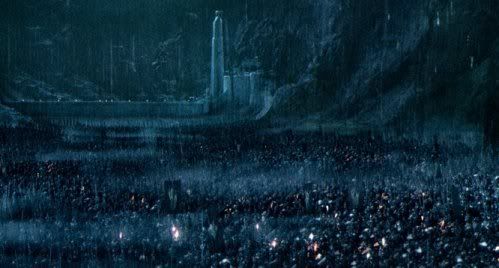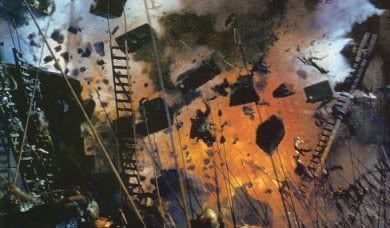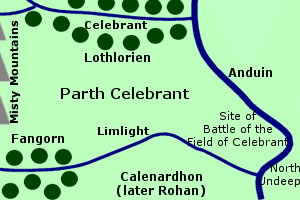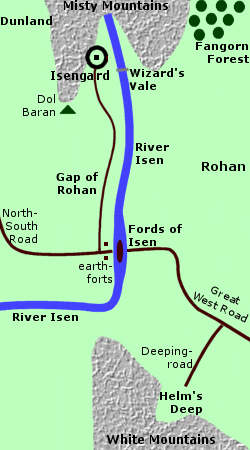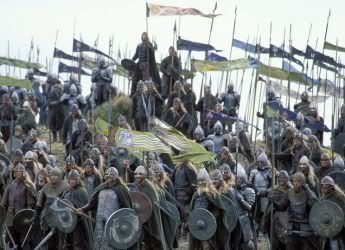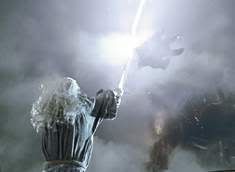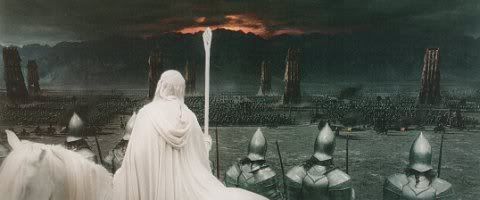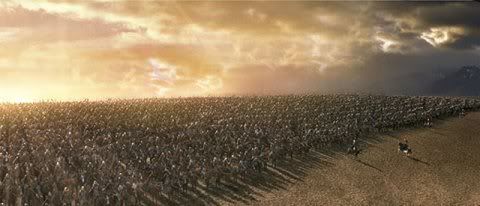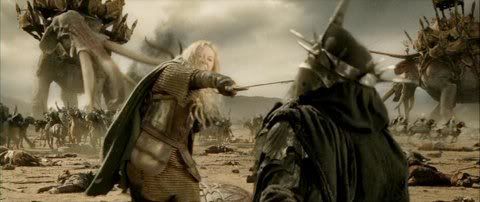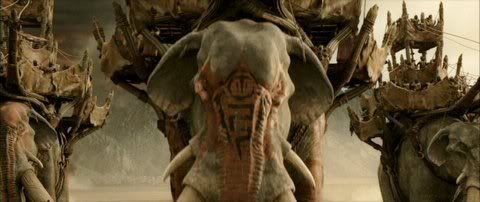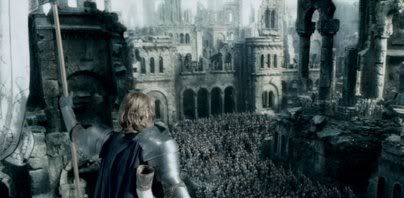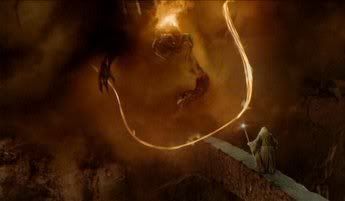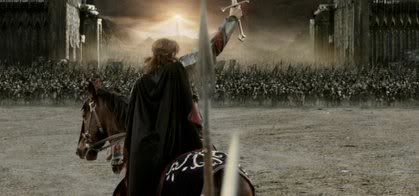Post by ladyarwen on Oct 29, 2007 11:23:28 GMT -5



Battle of Bywater
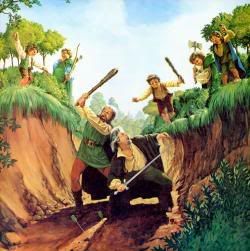
Battle between Hobbits and Men in the Shire. The Battle of Bywater was the last battle of the War of the Ring. The battle was fought on November 3, 3019, in the village of Bywater. The Hobbits defeated the Men and freed their land from the rule of the invaders.
Men had started coming to the Shire in late 3018. Many of them were ruffians from the South and some even seemed to have Orc blood. At first they worked for Lotho Sackville-Baggins, who was expanding his business interests and selling goods from the Shire to outsiders including the Wizard Saruman. Lotho had Mayor Will Whitfoot arrested and set himself up as Chief, and the Men came to be called the Chief's Men. The Chief's Men intimidated the Hobbits and arrested anyone who tried to stand up to them. In September of 3019, Saruman came to the Shire and took over as Chief.
When Frodo Baggins and his companions returned to the Shire and came to Bywater on November 2, they began to rally the Hobbits to expel the invaders. Merry Brandybuck blew the Horn of the Mark and over 200 Hobbits from the Bywater area answered the call. They drove off a group of twenty Men, but the Men sent scouts to bring reinforcements from Waymeet. Pippin Took rode off to Tookland to rally the Tooks.
Merry was in charge of organizing the Hobbitry and he used his war experience to prepare them for the upcoming battle. He had barriers set up on the roads and posted look-outs for the night. He rode towards Waymeet and returned at 10 o'clock on the morning of November 3 with the news that around 100 Men were heading toward Bywater. Pippin arrived before the Men, leading 100 Hobbits from Tookland.
Under Merry's direction, the Hobbits had set up a barricade of carts about a furlong up Bywater Road at a point where there were high banks and hedges on either side of the road. When the Men came up the road the Hobbits pushed more carts in behind them, and the Men found that they were trapped in a confined space with armed Hobbits looking down on them from the banks above.
The Men were leaderless and inexperienced in battle; they were used to ruling by intimidation and had not expected such an organized resistance. Some of the Men fled, but others fought fiercely and several Hobbits were killed. Merry and Pippin then charged the ruffians from the east side and Merry slew the leader, who appeared to be part Orc. The rest of the Men were surrounded by Hobbit archers. Those who had escaped were pursued and the Men were driven out of the Shire.
In the end, nearly 70 Men were killed and 12 were taken prisoner, while 19 Hobbits died and about 30 were wounded. The dead Men were buried in a nearby sand-pit that came to be called the Battle Pit. The Hobbits were buried separately, and a stone was placed on their grave with a garden around it. A Roll was made of the names of all the Hobbits who fought in the Battle of Bywater, with Captains Meriadoc Brandybuck and Peregrin Took listed at the top.
The Battle of Bywater was the last battle fought in the Shire. The only other battle that had been fought in the Shire was the Battle of Greenfields.
Battle of Dagorlad
Battle of Dale
Battle in the north during the War of the Ring. The Battle of Dale began on March 15, 3019*. An army of Easterlings allied to Sauron crossed the Redwater and King Brand of Dale was forced to retreat to the foot of the Lonely Mountain. The Dwarves of the Lonely Mountain led by King Dain came to the aid of the Men of Dale. The battle lasted three days.
On March 17, King Brand was slain, and Dain stood over Brand's body wielding his axe until he too was killed. The Easterlings were victorious, but they could not take the Lonely Mountain and many Dwarves and Men took refuge there. They were besieged by the Easterlings until March 27, when news of the downfall of Sauron reached the north. Then Brand's son Bard II and Dain's son Thorin Stonehelm led their forces out of the mountain and drove the Easterlings away into the East.
*Note:
The only date given for the Battle of Dale is March 17, the day Brand and Dain were killed. Their deaths appear to have been at the end of the battle. Also, it is said that the Battle of Dale began while Minas Tirith was besieged. Therefore the starting date of the three-day battle appears to be March 15.
Battle of Fornost

Battle between the forces of the Witch-king of Angmar and the combined forces of the Dunedain of the North, Elves of Lindon and Rivendell, and Men of Gondor. The Battle of Fornost was fought in 1975 on the plain west of Fornost between the North Downs and Lake Evendim. The battle resulted in the Witch-king's defeat, but it also marked the end of the North-kingdom of Arnor.
The Witch-king was the Lord of the Nazgul, and he had been troubling the Dunedain of the North since he established the realm of Angmar in 1300. In the winter of 1974, a great force from Angmar captured Fornost, which was the capital of what remained of the North-kingdom. The Witch-king himself took command of the city.
Most of the Dunedain fled west across the River Lune to Lindon, but some led by King Arvedui held out for a time in the North Downs. They were soon forced to retreat northward to the Icebay of Forochel. A ship was sent from the Grey Havens to rescue them, but it was lost at Sea in March of 1975 and Arvedui and all aboard perished.
A fleet finally arrived from Gondor in repsonse to a request for aid that Arvedui had sent before the invasion. There were so many ships that they filled all the harborage in the Gulf of Lune. The fleet brought a great army led by Earnur, the son of King Earnil II of Gondor, as well as cavalry that included horsemen from Rhovanion. They joined forces with the remaining Dunedain of the North and the Elves of Lindon led by Cirdan to form the Host of the West. Some archers from the Shire accompanied them.
The Host of the West crossed the Lune and headed for the Hills of Evendim. The Witch-king was over-confident, and rather than waiting for the Host to try to retake Fornost, he sent his army out to meet them. The Host of the West came down out of the hills onto the plain and engaged the forces of Angmar in battle.
The forces of Angmar started to retreat toward Fornost. Then their flank was attacked by the cavalry of the Host of the West, who had circled around the Hills of Evendim to come down from the north. The forces of Angmar were routed. The Witch-king tried to retreat to his stronghold of Carn Dum with the remnants of his troops, but he was pursued by cavalry led by Earnur. Earnur was joined by Glorfindel and an army of Elves from Rivendell, and together they finished off the Witch-king's forces.
The Witch-king turned on Earnur, who tried to stand his ground but was unable to control his terrified horse. Then Glorfindel approached, and the Witch-king fled into the night. Earnur wanted to pursue him, but Glorfindel said, "Far off yet is his doom, and not by the hand of man will he fall." (LotR, App. A, p. 332)
The Orcs and Men in the service of Angmar had all been slain or driven away, and the Witch-king returned to Mordor. Over 1,000 years later, Glorfindel's prediction came to pass when the Witch-king was vanquished at the Battle of the Pelennor Fields by a woman and a Hobbit.
Despite the victory over Angmar, the Dunedain of the North were greatly diminished and weakened, and the North-kingdom of Arnor could no longer be sustained. Fornost remained abandoned, and the Dunedain became a wandering people called Rangers by the people of Eriador. It was not until the end of the Third Age that the North-kingdom was reestablished by Aragorn, King Elessar.
Names & Etymology:
The Battle of Fornost took its name from the nearby capital city of Fornost, meaning "northern fortress."
War of the Last Alliance

War between Sauron and an alliance of Elves and Men at the end of the Second Age. The war was fought in and around Mordor between 3434 and 3441 of the Second Age. In the end Sauron was defeated and the One Ring was taken from him, but since the Ring was not destroyed Sauron was able to rise to power again in the Third Age.
The Last Alliance of Elves and Men:
The Last Alliance of Elves and Men was formed in 3430 by Gil-galad, the High King of the Noldor, and Elendil, the High King of Gondor and Arnor. They united to oppose Sauron, who had attacked and captured Minas Ithil - a stronghold of Gondor on the borders of Mordor - the year before in 3429. Sauron was angry that the survivors of Numenor had founded the Kingdom of Gondor near his realm, and he sought to destroy them.
Elendil's son Isildur escaped from Minas Ithil and fled to Arnor in the north where his father lived. Elendil's other son Anarion remained to defend Gondor. Anarion managed to hold Osgiliath and drive Sauron's forces back to Mordor for the time being, but he did not have sufficient strength to defeat Sauron.
Elendil took counsel with his friend and ally Gil-galad, and they realized that their races needed to unite against Sauron or all of Middle-earth would be in danger. Gil-galad set out with an army of Elves from Lindon, along with Cirdan from the Grey Havens. Elendil gathered an army of Men of Arnor and awaited Gil-galad in the Tower of Amon Sul on Weathertop. Together they traveled to Rivendell, the home of Elrond, who was to act as Gil-galad's herald and commander on the battlefield.
In 3431, a great host of Elves and Men was assembled at Rivendell, the likes of which was never seen again in Middle-earth. The army of the Last Alliance set out for Mordor, crossing the Misty Mountains in 3434 and marching down the Anduin. They were joined by Elves of Lothlorien led by Amdir and Elves of Greenwood the Great led by Oropher and his son Thranduil. Some Dwarves of Durin's line from Khazad-dum as well as a small number of Dwarves from other houses also joined them.
South of Greenwood the Great, the army of the Last Alliance found that the gardens that the Entwives had tended there had been destroyed. Sauron had burned the gardens in a scorched earth policy in order to prevent the Last Alliance from replenishing their supplies with the Entwives' crops. The army continued south through the desolate Brown Lands to Mordor.
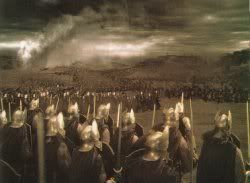
The Battle of Dagorlad:
In 3434, the armies of the Last Alliance and Sauron met in battle outside the Black Gate of Mordor on the great plain that became known as Dagorlad, the Battle Plain. The army of the Last Alliance consisted of the forces that had marched from the north and the Men of Gondor who had been defending their borders.
Last Alliance - MenHowever, the Men who lived in the White Mountains did not heed the call to battle despite an oath they had sworn to Isildur to oppose Sauron. These Men of the Mountains were cursed as Oathbreakers by Isildur and were condemned to haunt the Paths of the Dead.
Sauron's forces consisted mainly of Orcs and Men. Many of the Men who fought for Sauron came from the lands of Rhun in the East and Harad in the South. There were also some Men of Numenor who had been corrupted by Sauron and were called Black Numenoreans. Two of these Black Numenoreans named Herumor and Fuinur had become lords among the Haradrim and led their people into battle against Elendil and Gil-galad.
A small number of Dwarves fought on Sauron's side, though none from Durin's line. Sauron also had at his command Trolls and other creatures as well as his deadliest servants, the Nazgul.
When the battle began, Oropher of Greenwood the Great did not wait for Gil-galad's signal and charged heedlessly forward to his death. The Elves of Lorien led by Amdir also fared poorly. They were cut off from their allies and were driven into the the marshland to the south, where Amdir and more than half his troops were killed. This marshland became known as the Dead Marshes because of the corpses of Elves, Men, and Orcs that lay there after the War of the Last Alliance.
But the main forces led by Elendil and Gil-galad were victorious against Sauron in the Battle of Dagorlad. The enemy forces feared Aeglos, the spear of Gil-galad, and Narsil, the sword of Elendil, and they could not withstand the united front of the Elves and Men of the Last Alliance. Sauron retreated to Mordor and barricaded himself in Barad-dur, the Dark Tower.
The Siege of Barad-dur:
The Siege of Barad-dur lasted for seven years, from 3434 to 3441. The army of the Last Alliance entered Mordor and surrounded the Dark Tower, but they could not break its defenses. Isildur sent his sons Aratan and Ciryon to Minas Ithil to guard against any attempt by Sauron to escape by way of Cirith Ungol. Isildur's eldest son Elendur remained at his side throughout the war.
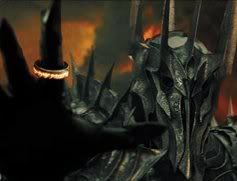
Sauron sent out many sorties from the tower and he also attacked the siege army from above with fire and with arrows and other projectiles. Many Elves and Men were killed. Anarion died in 3440, his helmet crushed by a stone thrown from Barad-dur.
Finally in 3441, Sauron came down from his tower in an attempt to break the siege. He made his way to Mount Doom, where he was confronted by Gil-galad and Elendil. The three fought on the slopes of Mount Doom until all of them fell. Gil-galad was burned to death by the heat of Sauron's hand, and as Elendil died his sword Narsil broke beneath him.
Sauron's physical body was also cast down. Isildur cut the One Ring from Sauron's hand with the hilt-shard of Narsil. Elrond and Cirdan advised him to destroy it immediately in the fires of Mount Doom, but Isildur refused and kept the Ring for himself. Because the Ring which contained much of his power remained, Sauron's spirit survived.
After the War:
Although the war ended in victory for the Last Alliance, the defeat of Sauron was not complete. He fled to the East where he rebuilt his strength over the centuries. The Nazgul also went into hiding, awaiting their master's return to power. Many of the Men who had been allied with Sauron returned to their homelands and remained enemies of Gondor and Arnor. Barad-dur was destroyed but its foundations, which had been strengthened with the power of the One Ring, stood intact.
The Elves and Men of the Last Alliance suffered great losses in the war. More than half of the forces from Lothlorien and two-thirds of the forces from Greenwood had perished. A remnant of the Elves of Lindon returned with Cirdan to dwell at the Grey Havens.
Isildur was killed just two years after the war by a band of Orcs in the Gladden Fields, and the One Ring was lost in the waters. The population of Arnor had been greatly diminished, and the North-kingdom declined and eventually ended after a war with the Lord of the Nazgul. Gondor's losses were less grievous, but it was not long before they too were under attack by Sauron's minions.
By the end of the Third Age, Sauron had regained much of his power and returned to Mordor. It was not until the One Ring was finally destroyed on March 25, 3019, that Sauron was utterly defeated.
Names & Etymology:
The Last Alliance was so called because it was the last time Elves and Men came together in great force for a common purpose. The two races became estranged during the Third Age, and although a number of Elves aided the Fellowship and fought to defend their own realms during the War of the Ring they did not form a united front with Men against Sauron as they had during the Last Alliance.
The Battle of Dagorlad was fought on the plain in front of the Black Gate which came to be called Dagorlad, or the Battle Plain, from dagor meaning "b


